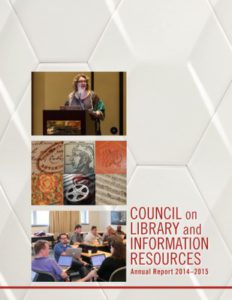Annual reports published since 2007–2008 are available in electronic form only.
Download PDF of latest Annual Report >>
Letter from the President
 Another productive, celebratory year for CLIR: the Council continues to flourish, expand its membership, and integrate with programs, projects, and issues of international reach.
Another productive, celebratory year for CLIR: the Council continues to flourish, expand its membership, and integrate with programs, projects, and issues of international reach.
Prominent new staff appointments this year include Bethany Nowviskie, who arrived in April as the director of the Digital Library Federation (DLF), and Nikki Ferraiolo, program officer for scholarly resources. Bethany brings a wealth of scholarship, teaching, and mentoring skills to DLF and CLIR. Her work at the Scholar’s Lab at the University of Virginia, her leadership in the international flourishing of digital humanities over the past decade and the increasing awareness of this field of research as integral to the evolution of the grand tradition of humanistic inquiry, and her foundational role promoting the concept and beneficial consequences of alternative careers in the academy will strengthen the mission of DLF and attract an ever-widening constituency.
Nikki brings program and research expertise from her work at Columbia, both as a masters’ student and as program manager in the history department. She joined CLIR just before the launch of the new digitizing hidden collections program and has brought great energy and intelligence to the effort in its first year. She was also a key organizing force behind the Hidden Collections Symposium-the capstone event for the seven-year cataloging program-in March 2015.
The appointment in June 2014 of Michael Edson, director of web and new media strategy at the Smithsonian Institution, as CLIR Distinguished Presidential Fellow also marks an important augmentation to CLIR’s mission. Michael is widely recognized as an articulate futurist who explores the potential of technology for museums and archives as a means to better understand our growing dependence on visual culture. Michael’s vision is ably expressed in a proposal he brought to CLIR this spring: Openlab, a project that will serve as instigator, incubator, and digital studio to accelerate the adoption of technologies and best practices across libraries, galleries, archives, and museums to catalyze sector-wide change.
This year also marked the publication of well-received research studies and reports. Two epitomize the range of CLIR’s purview. The ARSC Guide to Audio Preservation was commissioned in response to the severe risk of media deterioration and the limited funding to address this crisis. The guide is a practical introduction to caring for and preserving audio collections. It is aimed at individuals and institutions that have recorded sound collections but lack the expertise in one or more areas to preserve them. The Changing Landscape of Library and Information Services: What Presidents, Provosts, and Finance Officers Need to Know is a report that elaborates upon a productive meeting of CLIR’s CIOs in which key contemporary issues and challenges in library and technology services were enumerated.
CLIR received several important grants this year; of particular note was the generous support from The Andrew W. Mellon Foundation for the Digitization of Hidden Special Collections and Archives. This grant inaugurates the new iteration of the national competition begun with the Cataloging Hidden Special Collections and Archives program. Our digitization program aspires to encourage approaches to digitization that make possible new kinds of scholarship in the digital research environment; support the digitization of entire collections; promote strategic partnerships; promote best practices for ensuring the long-term availability and discoverability of digital content; and ensure that digitized content is made available to the public as easily and completely as possible. In addition to producing a wealth of digital objects of great cultural value, a salient goal is to facilitate the adoption of standards and best practices that will result in a coherent, sustainable academic digital library of unprecedented scope.
New to this year’s annual report is the category of Affiliates. We are using the term in a general way, to indicate a close programmatic alliance or association-a working relationship with many possible characteristics. The organizations listed bring to CLIR a variety of mutually beneficial opportunities. For example, NITLE is a program temporarily housed within CLIR as we work with its constituency to determine the services and resources that would help reinvigorate the institution; NITLE may remain a part of CLIR if its members so recommend. The International Interoperable Image Framework (IIIF) is an affiliate by virtue of our promotional support of the framework, our assistance with administering finances, and our mentoring of staff IIIF plans to hire in the coming years. These and other organizations that joined us subsequent to June 2015, including the National Digital Stewardship Alliance (NDSA) and the iSchool Consortium, offer a rich diversity of perspectives and interests while at the same time collectively strengthening our mission: collaborating with libraries, cultural institutions, and communities of higher learning to enhance research, teaching, and learning.

